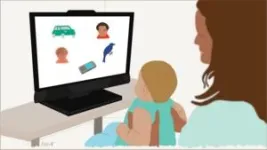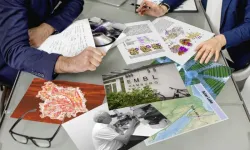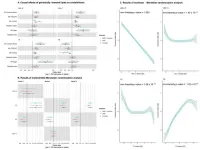(Press-News.org) Whether infants at five months of age look mostly at faces or non-social objects such as cars or mobile phones is largely determined by genes. This has now been demonstrated by researchers at Uppsala University and Karolinska Institutet. The findings suggest that there is a biological basis for how infants create their unique visual experiences and which things they learn most about. The study has been published in the scientific journal Nature Human Behaviour.
The way in which we explore our environment with our eyes affects what we notice, think about and learn. The new study analysed preference for faces versus non-social objects in more than 500 infant twins.
“Our results suggest that even before infants can influence and choose their environment by pointing, crawling or walking, they create their own unique perceptual experiences by systematically looking more at social or non-social objects, preferences that can be largely explained by genetic differences between children,” says Ana Maria Portugal, Postdoctoral Researcher and first author of the study.
The children’s gaze was measured using an infant friendly eye tracker. The results showed that individual infants’ preference for faces could be largely explained by their genetics. The family environment did not explain preferences for social versus non-social information this early in life.
The researchers found that more looking at faces versus non-social objects at five months of age was associated with having a larger vocabulary in the second year of life. This supports the view that there is a link between early looking preferences and later development.
Differences in looking behaviour can potentially affect the interaction between parent and child.
Whether an infant looks at faces or not is a strong signal to other people and can influence parents’ behaviour towards their child. However, it should be remembered that looking at a lot of non-social objects is not necessarily negative – it is also important for cognitive development, explains Portugal.
The study is part of the Babytwins Study Sweden (BATSS) research project where identical and fraternal twins have been tested using different child-friendly methods at the Karolinska Institutet Center for Neurodevelopmental Disorders (KIND). The children were followed from five months to three years of age, but eye tracking was only conducted at 5 months.
Portugal found that the looking preferences of the genetically identical twins were more similar than those of the fraternal twins. For example: if one identical twin in the pair looked mostly at non-social objects, there was a large chance that the other twin had the same preference. In contrast to identical twins, fraternal twins on average share only 50% of their genes. Their looking preferences tended to be less similar within each pair of twins.
In addition to the link to later language development, the researchers examined whether visual preferences could predict whether the infants, later in childhood, exhibited behaviours characteristic of autism, which is defined by difficulties with social communication. They also tested whether there were gender differences in facial preference.
“Our results indicate that face preference in infants is not strongly associated with social communication ability later in childhood. We also found no difference between boys and girls in terms of preference for faces versus non-social objects,” notes Terje Falck-Ytter, Professor at the Department of Psychology at Uppsala university and principal investigator in the BATSS study.
“Moreover, our data showed that the genes which influence facial preference are not the same as those involved in eye contact – that is, whether infants looked primarily at the eyes or the mouth when looking at a face. It’s fascinating that two basic social behaviours like looking at faces and looking at eyes have different genetic and probably evolutionary bases,” adds Professor Falck-Ytter.
Portugal, Ana Maria et al. (2023), Infants' looking preferences for social versus non-social objects reflect genetic variation, Nature Human Behavior. DOI: 10.1038/s41562-023-01764-w, https://doi.org/10.1038/s41562-023-01764-w
END
A Perspective article published today in Nature Geoscience tackles the longstanding issue of gender representation in science, focusing on the field of ice core science. Prior work has shown that despite progress toward gender parity over the past fifty years1, women continue to be significantly underrepresented within the discipline of Earth sciences2 and receive disproportionately fewer opportunities for recognition, such as invited talks, awards, and nominations3. This lack of opportunity can have long-term negative impacts on women’s careers. To help address these persistent gender gaps, the study evaluates patterns related to women’s publication in ice core science over the ...
Ahab hunting down Moby Dick. Wile E. Coyote chasing the Road Runner. Learning Latin. Walking over hot coals. Standing in a long line for boba tea or entrance to a small, overpriced clothing retail store. Forking up for luxury nonsense.
What do these activities have in common? They’re all examples of the overvaluation of what economists call “sunk costs”: the price you’ve already irretrievably paid in time, money, effort, suffering or any combination of them for an item, an experience or a sense of self-esteem.
It’s a ...
An intense international effort to improve the resolution of magnetic resonance imaging (MRI) for studying the human brain has culminated in an ultra-high resolution 7 Tesla scanner that records up to 10 times more detail than current 7T scanners and over 50 times more detail than current 3T scanners, the mainstay of most hospitals.
The dramatically improved resolution means that scientists can see functional MRI (fMRI) features 0.4 millimeters across, compared to the 2 or 3 millimeters typical of today's standard 3T fMRIs.
"The NexGen 7T scanner is a new tool that allows us to look at the brain circuitry underlying different diseases of the brain with ...
During the nearly five decades of its operation, the European Molecular Biology Laboratory (EMBL) in Hamburg has developed many fruitful collaborations with other scientific institutions located in the Hamburg metropolitan area. One example is the long-lasting collaboration between researchers at EMBL Hamburg and the Center for Biobased Solutions (CBBS) at the Hamburg University of Technology (TUHH), which has recently yielded new insights into the structure and function of a lipid-degrading enzyme found in a microbe adapted to living in extreme conditions. The findings could help improve ...
The return of bluefin tuna to Northern European waters is a conservation success story, but rising sea temperatures in their Mediterranean nursery grounds mean this recovery may be short-lived, according to new research led by the University of Southampton.
Temperatures expected in the Mediterranean within the next 50 years are expected to drive juvenile tuna out of the Mediterranean, where they may be accidentally caught in existing sardine and anchovy fisheries – requiring fishery managers to adapt their methods to allow tuna nurseries to establish.
Outlining the research, published in Nature, lead author Clive Trueman, Professor of Geochemical Ecology ...
A new study published in the journal Gut has shed light on the complex relationship between serum lipids, lipid-modifying targets, and cholelithiasis, a common condition characterized by the formation of gallstones. The study, led by researchers at the First Hospital of Jilin University, employed a combination of observational and Mendelian randomization (MR) approaches to comprehensively assess these associations.
Cholelithiasis is a prevalent hepatobiliary disorder that primarily affects Western populations. It is a significant risk factor for cholangiocarcinoma, ...
With images - the visual assets can be downloaded by clicking on this WeTransfer link:https://we.tl/t-mbRtSW5BzO
*See further information at end of release for captions and required pic credits
A Leeds researcher is keen to help beekeepers shape their practices following his study which appears to disprove the widespread belief that honeybees naturally insulate their colonies against the cold. His findings suggest that the creatures are potentially being subjected to thermally-induced ...
A large amount of the heavy automobile pollution from Copenhagen’s Bispeengbuen thoroughfare goes straight into people's homes. This, according to a study by researchers at the University of Copenhagen. A sensor developed by one of the researchers can help fill in the blanks of our understanding about local air pollution.
Air pollution cuts the lives of more than four thousand Danes short every year. Locally, we have a very limited understanding how many harmful substances waft in the air we breath. Indeed, air pollution is only monitored at fourteen locations across Denmark.
This ...
COLUMBUS, Ohio – Despite the many challenges they face, slightly more than half of unmarried low-income couples with children have positive co-parenting relationships, a new study found.
And those supportive relationships were linked to their children showing more empathy, less emotional insecurity and fewer behavior problems.
Parents who are good co-parents work together as a team, provide support to each other and back up each other’s parenting decisions, said Susan Yoon, lead author of the study and associate professor of social work at The Ohio State University.
Those types of relationships may be particularly hard for the parents in this study, ...
A common concern about gender-affirming hormone therapy for transmasculine people is the risk of red blood cell volume changes and erythrocytosis, a high concentration of red blood cells, with the use of prescribed testosterone. However, Mount Sinai researchers have found that testosterone treatment may be safer than previously reported, with results published today in The Journal of Clinical Endocrinology and Metabolism.
Mount Sinai researchers from the Division of Endocrinology and Center for Transgender Medicine and Surgery examined the relationship between the use of testosterone as part ...







